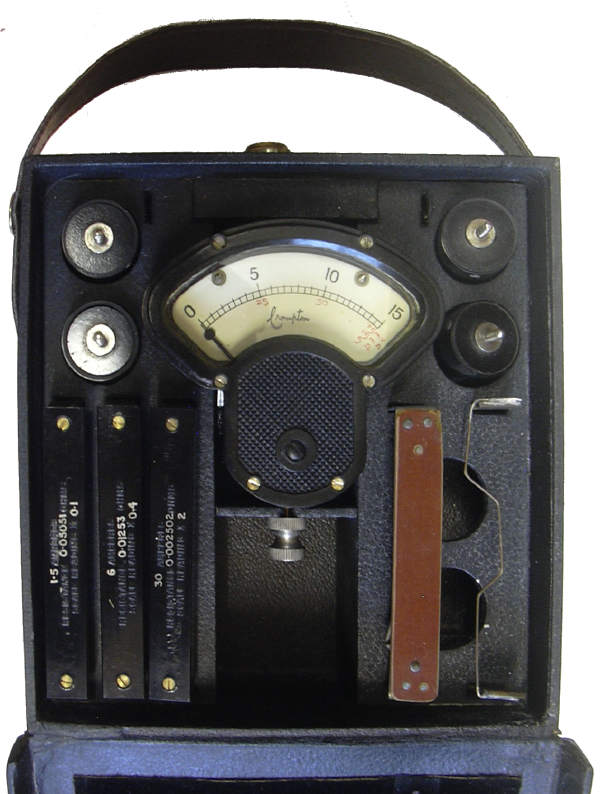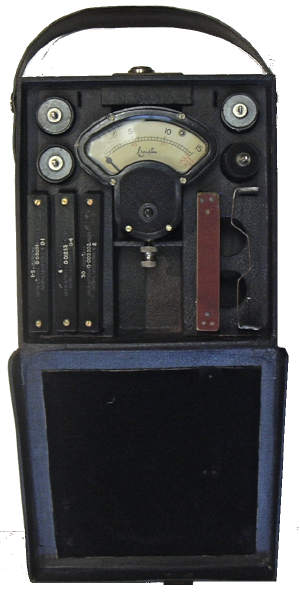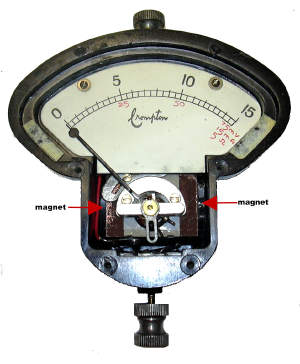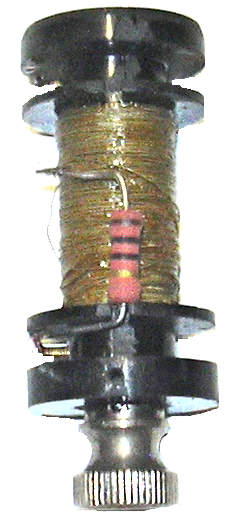

Crompton moving coil [15mA/75mV] meter in leatherette case housing multipliers and shunts to extend the range. The internal swamp resistor has been replaced by a modern equivalent. Working. UK manufacture probably 1937-40.
This is one of many instruments collected by Jack Davidson C Eng
FIEE which I have been given by Dr Graham Winbolt.


As can be seen here the instrument has four cylindrical multipliers and five shunts, two of which are home made and there are spaces for two more multipliers. I tried the meter with a 15 volt multiplier and a variable voltage DC power supply and soon established that it was indicating about 85% of the correct value. When I removed the scale plate I found that a previous owner had replaced the swamp resistor with a carbon one in parallel with a small potentiometer. These were replaced with a single one which brought the terminal resistance to as near as I could get to 5 ohms. Still the meter was reading low despite the resistance of the multiplier being correct. I reasoned that the problem must lie with the magnet or maybe with a shorted turn on the moving coil. I could do nothing with the latter but hit upon a way that might increase the magnetic field and get the pointer moving further. I have a tin box in which I keep magnets and have several from old hard disk drives. These are powerful, slim, brittle and easily broken and two halves of one magnet [see picture below] were inserted either side of the horse shoe magnet did the trick. A combination of positioning of the magnets and the magnetic shunt enabled the meter to read correctly at 10 and 15 volts on the scale.


When I tried the 6 Volt multiplier the readings were haywire. What was wrong? The resistance of the multiplier was about 188 ohms and on opening it up It had clearly always been that way. But for 6 Volts the resistance should have been much higher. I concluded that this must have been made for a different meter and that the solution would be to increase the value to 195 ohms and re-label it as a 3 Volt multiplier.[see picture above]
The back of the meter scale is inscribed in pencil "W B Nicholson 0-15AT our name 541943" So could the meter have been made or perhaps re-scaled in 1943?
Matt Gadfield found this
page while searching for information on some Crompton Parkinson test
meters he rescued from the scrap pile at work. He also found an original instruction manual for them
(dated 1951) which explained the use of the shunts, bobbins and the
rectifier unit to measure AC voltage and described the larger
"Universal Indicator". Matt made a short video about them for YouTube https://youtu.be/5VXK3_ohMmM
aimed it at anyone who'd found one in an old cupboard and wanted to
know what the various parts did. Some are branded as Philip Harris and
Griffin and George with the small Crompton shield logo, identical aside
from the name printed on the scale. The following is reproduced from
the instruction manual.

History
Crompton and Co can trace its roots back to 1878 and initially was
involved with motors, generators and electric lighting. Meter
manufacture started in 1910. From 1927 the firm Traded as Crompton
Parkinson and sometime later Crompton Instruments was formed which is
now part of Tyco Electronics UK Limited. You will find more information
here: www.gracesguide.co.uk/Crompton_and_Co

